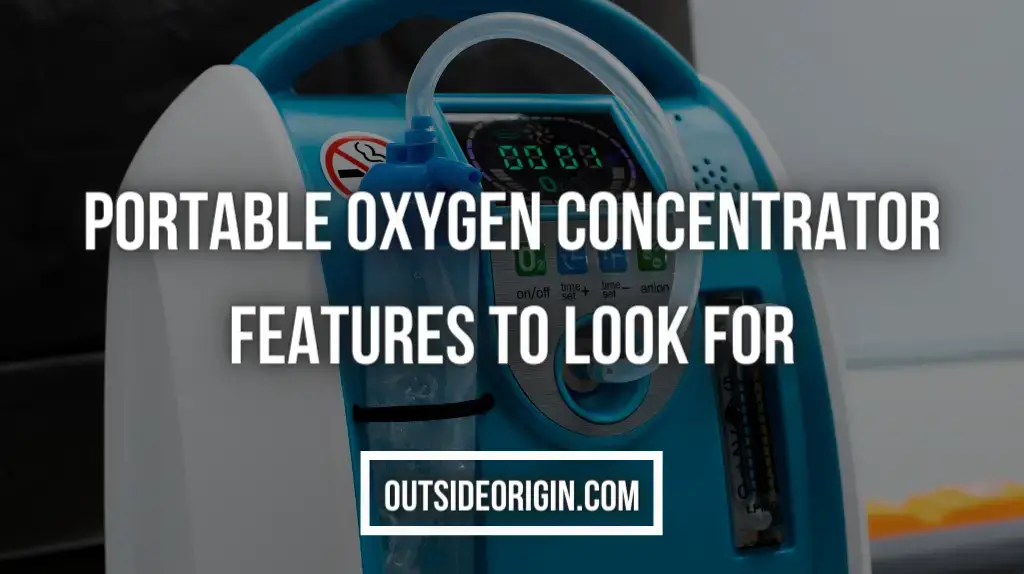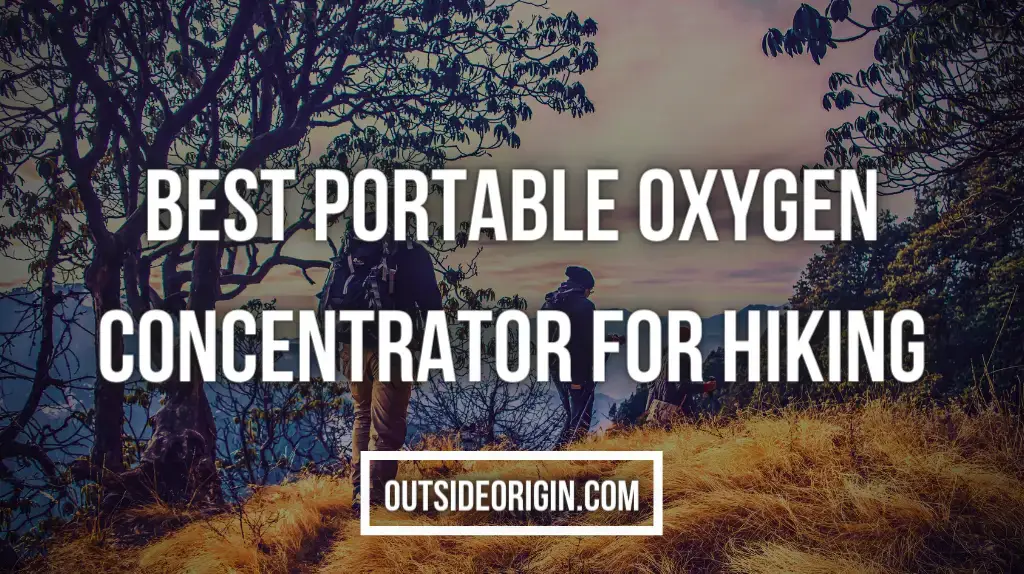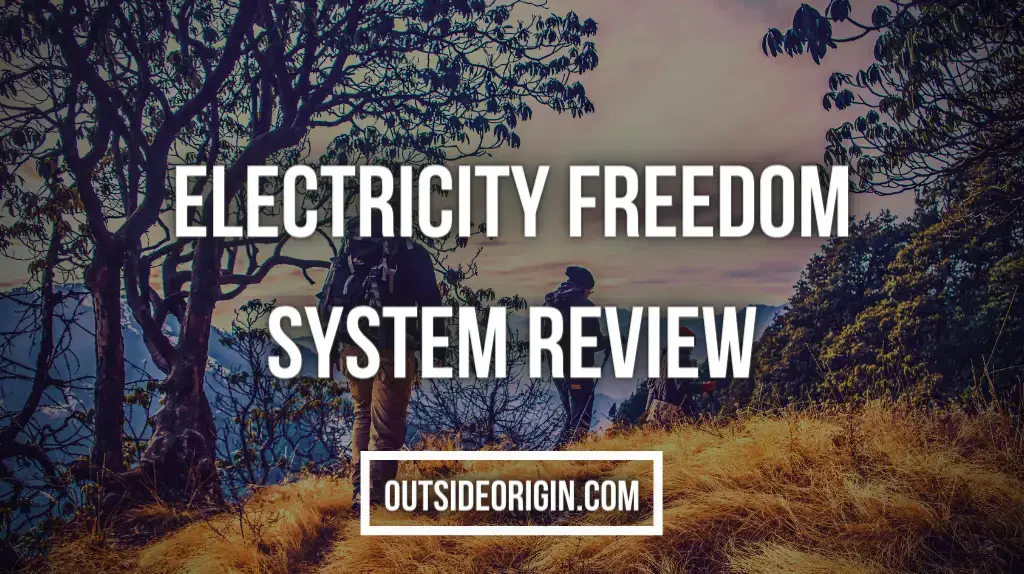Hiking is a great way to stay physically active, fit, and healthy. Small, portable, and lightweight portable oxygen concentrators are ideal for short trips like day hikes or mountain adventures if you need oxygen therapy. These portable concentrators are small but mighty, and they’ll let you go about your day with a sense of independence. Hiking is a great way to stay in shape while you’re on a mountain adventure.
Aside from being life-saving medical devices, portable oxygen concentrators have become increasingly popular. People with pulmonary, cardiac, and blood disorders can rely on them for supplemental oxygen. Additionally, they’re portable, as opposed to stationary oxygen concentrators, because they run on batteries and don’t need to be plugged in. Rather than relying on a concentrator powered by AC, users can use these portable portal devices instead.
1. Inogen One G3 External Battery Charger | Portable Oxygen Concentrators
One of the calmest portable oxygen concentrators available, the G3 has a lot more to offer than just quietness. In addition, it has a 4-hour battery life and a maximum altitude of 10,000 feet. Also, the case looks more like a lunchbox than a medical device.
Audible alerts in the event of a power outage, no-breath-detected alarms, and oxygen purity checks are all features of the G3. In the event that your oxygen level drops below the required purity levels, you’ll know about it immediately.
Pros
- Quiet
- Audio warnings
- Long Battery life of four hours
Cons
- A lack of a steady stream
- Only the standard filter is utilized.
Where to purchase Inogen One G3 External Battery Charger?
You can purchase Inogen One G3 External Battery Charger here on Amazon.
2. iProven Pulse Oximeter Fingertip Oxygen Concentrator
The infrared technology in the IprovenS OXI-27 makes it a breeze to operate. Ten seconds later, your SpO2 (oxygen saturation) and pulse rate are displayed on the screen.
Every second, the oximeter provides you with a real-time update of your readings. Automatically, it saves battery power. Small enough to fit in your pocket. You may take it with you and use it everywhere you go. A single-button procedure With the push of a button, you can begin taking measurements.
Prior to and following sporting events, the OXI-27 is designed for quick measurements. Your reading may be tainted if you move your fingers while you read. For the most accurate measurement, use nude nails.
Temperature affects blood flow, making it difficult to read SpO2 levels if you have cold fingers. The device can be used by adults and children over the age of four, with the square hole on the hinge side of the device used to connect a lanyard. 100% Skyblue SpO2 Levels in the OXI-27BL. / 1,3 inch/ 2,4 inch
Pros
- Auto-shutoff helps extend the battery’s life.
- A bar graph shows the current intensity of the signal strength in real time.
- Ten-second outcomes from infrared technology
Cons
- Readability is around average.
Where to Purchase iProven Pulse Oximeter Fingertip Oxygen Concentrator?
You can purchase iProven Pulse Oximeter Fingertip Oxygen Concentrator here on Amazon.
3. Inogen One G4 Replacement Column Pair | for Portable Oxygen Concentrator G4
Replacement sieve beds for the Inogen G4 mobile concentrator are available in the Inogen One G4 Column Set. These replacement columns have sieve beds that convert low oxygen air into medical-grade air. To get the most out of your G4 Columns, have them replaced every 12 to 18 months at the very least.
There are two columns in each order. By following a few simple steps, you may swap out the column pair without needing to take the device into a service center.
Pros
- Changing it out is a breeze for customers.
- Save money and time.
- Changing the column pair is a simple procedure that doesn’t require any instruments.
- The substance will degrade over time if it is used frequently.
- Sold in a set of two.
Cons
- Continuous flow of oxygen may not be sufficient for some users.
Where to Purchase Inogen One G4 Replacement Column Pair?
You can purchase Inogen One G4 Replacement Column Pair here on Amazon.
4. CURMIO Portable Oxygen Concentrator
The oxygen concentrator from Curmio is made of heavy-duty nylon to prevent scuffs. The battery’s heat dissipation and ventilation are ensured by the mesh design.
A two-way zipper can be fully opened so that your machine can be easily taken in and out of the case. An insulated bottle holder with a detachable insulator for taking your water bottle with you on the go.
Large enough to fit a 14-inch laptop, batteries, and other personal belongings, as well as instructions. Size: 9.5″x4.5″x10.7″ (Front Compartment) 9.5″x7″x15″(Back Compartment) (Whole Bag). Suitable for a variety of activities, including travel, walking, and shopping.
Pros
- Ease-of-use
- Lightweight
- Durable
- Extended battery life
- Economical in terms of energy
Cons
- There are no “smart” features.
Where to Purchase CURMIO Portable Oxygen Concentrator?
You can purchase CURMIO Portable Oxygen Concentrator here on Amazon.
5. Inogen One G4 External Battery Charger | Portable Oxygen Concentrators Accessories
If you’ve been on an oxygen concentrator for a while, or if you’ve recently been prescribed oxygen and are looking into your oxygen device alternatives, you’ve undoubtedly heard of Inogen.
Inogen’s portable oxygen concentrators were the first to be approved by the Federal Aviation Administration (FAA), a groundbreaking achievement in the oxygen treatment industry. Since then, Inogen has released other unique oxygen therapy products.
There is no better portable oxygen concentrator than the Inogen One G4 when it comes to making your life easier or giving you the freedom of travel that only an Inogen One G4 can bring.
Pros
- Intuitive User Interface
- Approved for Nighttime Use
- Good Pulse Flow Oxygen Output
- The battery lasts a long time
Cons
- A bit noisy
- Only has a standard filter
Where to Purchase Inogen One G4 External Battery Charger?
You can purchase Inogen One G4 External Battery Charger here on Amazon.
6. Portable Oxygen Concentrator Machine Health Care 7 Levels Adjustable
It comes with a one-year warranty and a 30-day return policy. Because of this, you can buy this oxygen concentrator machine with confidence. In addition, the remote controller makes it simple to use all of the features. The noise level is below 45 decibels (Sleeping mode)
Pros
- Durable
- Lightweight
- Quiet
- Multifunctional Features
Cons
- There are no “smart” features
- Working at a lower altitude than usual
Where to Purchase Portable Oxygen Concentrator Machine?
You can purchase Portable Oxygen Concentrator Machine here on Amazon.
Portable Oxygen Concentrator Features to Look for

Weight
Because they’re meant to be taken anywhere, size and weight, as well as the mode of transportation you choose, are important considerations. The heavier and larger the oxygen concentrator, the more power and output it has. A hectic lifestyle does not necessitate this, however. Many have a convenient rolling cart or strap system for easy transportation.
As a point of reference, the average weight of a portable computer is about 20 pounds. Because of its smaller size, a pulse flow device can weigh anywhere from three to ten pounds in total.
Type of Delivery and Flow
One type is based on the delivery of oxygenated air in pulses, while the other is based on a continuous flow. Short puffs of air are delivered to the patient by the pulse flow machine in response to each patient’s inhalation.
Because of this, no oxygen will be used up. When the patient inhales, the pulse flow or demand flow delivers oxygen. This can reduce the amount of energy used. Pulse-flow is more commonly used at night. In some cases, pulse-flow can be used in addition to continuous flow.
The continuous flow unit, on the other hand, produces oxygen in a continuous stream. Continuous oxygen flow of one to five liters per minute is a common method of delivering oxygen to patients, whether or not they are inhaling. Larger compressors are common in these devices, and it’s likely that some oxygen will be wasted.
Battery Lifespan
On average, portable oxygen concentrators can run for four to five hours on a single charge. Compact and lightweight devices usually have shorter battery life, but many of them come with extra batteries that can double the off-grid lifespan and charging options in cars. However, smaller and lighter devices have shorter battery life.
Output of Oxygen
The oxygen concentrator’s output capacity is by far the most important factor to consider when making a purchase. When compared to oxygen tanks, portable concentrators deliver a certain quantity of oxygen with each breath. Depending on the patient’s diagnosis, they typically need about 400 milliliters of fluid per minute.
It’s critical to discuss your specific needs with a physician to determine which machines will best maintain a stable level of oxygen saturation.
Accessories
There are a wide variety of add-on choices to further adapt the POC’s use to each individual’s unique demands for the smaller portable oxygen concentrators that come standard with the unit, a battery, an AC power source, a DC power supply, and a carrying case. Extra batteries and battery chargers, as well as sieve beds, filters, and panel vent covers, can all extend the life of the POC.
Filtration
A filtration system is standard on most portable oxygen concentrators. Those with lower immune systems or those who are more susceptible to respiratory infections can benefit from HEPA or antibacterial filters, which remove allergens and dust from the air.
Display
POCs benefit greatly from user-friendly interfaces and operational controls. Easy-to-read screens should be provided with large buttons so you don’t accidentally push them; alarms should notify you of difficulties like low batteries, oxygen flow issues and other operational failures.
The Importance of Portable Oxygen Concentrators at High Altitudes
If you’re planning a trip to a mountain town or planning on doing some skiing or hiking at a higher elevation, you should first evaluate how the altitude may affect your health. It doesn’t matter how old you are or how healthy you are; anyone can get altitude sickness. Those who have either lived close to sea level or have a lung condition like COPD, asthma, or pulmonary fibrosis are more likely to suffer from this condition (PF).
To put it simply, altitude sickness occurs when you rapidly ascend from a low altitude to a high one. Due to the body having a hard time adapting to the lack of oxygen, it can cause symptoms including dyspnea and nausea. Acute mountain sickness (AMS), high-altitude pulmonary edema (HAPE), and high-altitude cerebral edema are all forms of altitude sickness (HACE).
Among the several types of altitude sickness, acute mountain sickness is the most common and least severe. HAPE is the most common cause of death associated with altitude sickness, manifesting itself more rapidly and severely than AMS. Finally, cerebral edema is a side effect of HACE, a form of altitude sickness. In this case, fluid accumulates in the brain and can lead to confusion and possibly coma.
If you have COPD, having a steady supply of oxygen is critical. Even the mildest form of altitude sickness, AMS, can trigger exacerbations and low blood oxygen levels in COPD patients. To prepare for the altitude change, you’ll need a good portable oxygen concentrator and some advance planning. Additionally, if you engage in strenuous physical activity, such as trekking or skiing, your breathlessness will only worsen.
What Is The Function Of A Portable Oxygen Concentrator?
Portable oxygen concentrators, or POCs, are similar to home oxygen concentrators (OCs) in that they may be taken with you wherever you go. Some of these devices can be used on airplanes because they are small enough to carry.
Using an oxygen concentrator is as simple as the following:
- Air is drawn into the device from the surroundings.
- The apparatus compresses the air inside.
- The air is purified to remove nitrogen.
- A cannula or mask is used to inhale pure oxygen.
How Long Is The Average Lifespan Of Portable Concentrators?
Oxygen concentrators are designed to withstand the rigors of daily life, so they’re built to last. From five to seven years, depending on the concentrator and daily use, a new device should be expected to last.
A two-year warranty is typical for many of these products. It’s the same as purchasing a kitchen appliance. You’ll want to verify the warranty and make sure you’re dealing with a reputable seller or renter.
Using a Portable Oxygen Concentrator While Hiking
- Before beginning any exercise, make sure your concentrator is fully charged. In the middle of your workout, you don’t want it to stop operating.
- Plan to stop working out at least an hour before your portable oxygen concentrator’s battery dies. During your post-workout recovery, you will have access to at least an hour of oxygen.
- See if there are any local workout groups you may join. Exercise groups for COPD patients, oxygen therapy patients and others can be found through Facebook, the local library, or even your doctor’s office. Ask, and you’ll find out!
- Carry a spare cannula and a bag to store it in if necessary.
- Ask for help if you need it.
Conclusion: Final Thoughts!
If you’re planning to live or vacation at a high altitude, you’ll need to be sure your oxygen supply works properly. Consider the device’s portability, battery life, and reliability, as well as its maximum operating altitude, while selecting an oxygen supply.
The Federal Aviation Administration (FAA) has certified all of the devices on this list, so you can use your Portable Oxygen Concentrator on any commercial aircraft within the United States.
Oxygen Concentrator FAQs
Below are frequently asked questions on oxygen concentrators!
Do portable oxygen concentrators have a working mechanism?
Portable oxygen concentrators use a rechargeable battery or an electrical source to draw oxygen from the ambient air and filter it through sieve beds to remove nitrogen, just like bigger, plug-in oxygen concentrators for home usage. A nasal cannula coupled to the portable oxygen concentrator delivers the compressed oxygen to the patient.
Can you use a portable oxygen concentrator at night?
Even while sleeping with a portable oxygen concentrator is typically not a problem, you should always talk to your doctor about it. Some people may not be able to benefit from CPAP machines, while others may need them to cure sleep apnea more efficiently.
Are oxygen concentrators permitted on airplanes?
Portable oxygen concentrators are permitted in carry-on luggage and checked luggage on most airlines. Be sure to verify each country’s regulations if you’re flying internationally. Get in touch with the airline to make sure your POC complies with regulations and that you follow any particular procedures or instructions from the TSA or other government agencies (TSA).
Is a portable oxygen concentrator covered by Medicare?
For a portable oxygen concentrator, Medicare will pay a homecare equipment provider that you choose. However, the process is convoluted and depending on various things. Getting a tiny POC from a local supplier can be challenging because they usually only provide larger concentrators or systems that employ tanks for stationary home use.
Does insurance cover portable oxygen concentrators?
Despite the fact that portable oxygen concentrators are a lifesaver for people with a variety of respiratory problems and are considerably lighter and easier to transport than bulky oxygen tanks, insurance companies may refuse to cover the cost of one. Make sure all of your paperwork is in order, including your doctor’s order and essential patient information. Providing as much data as possible about how a POC would improve your quality of life over the use of normal oxygen tanks is often the best method to get your insurer to cover the expense.
Is the VA able to provide portable oxygen concentrators for hikers?
However, even though the VA does not normally provide portable oxygen concentrators for long-term usage, they do so for transitory scenarios like as aircraft journeys and other travel.
Can You Do Me A Small Favor?
We have put a lot of time & effort into writing this post to provide you with the best info out there.
It’ll help us out if you could consider sharing it on your social media networks. You are also allowed to take any photo you want from our blog as long as you credit and link back!
Appreciate it! ❤️️
Hey Guys I am Michael, I am a writer & editor at Outside Origin. I love being in the outdoors and I hike quite often. I have actually hiked at Inca Trail, Samaria Gorge, and Milford to name a few. I plan on visiting more locations and hiking trails!










